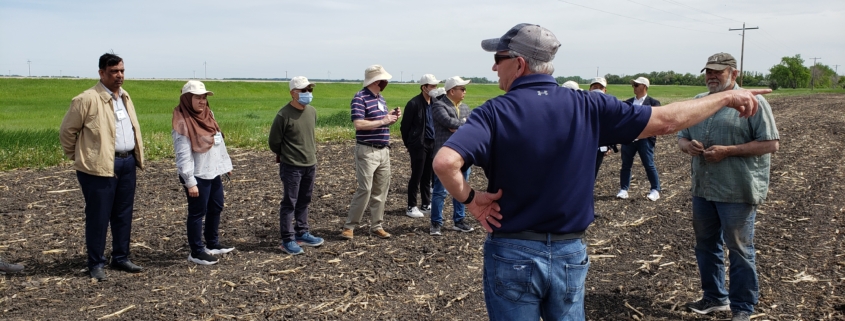IP Crop Network, March Report
This feature from SSGA’s Agronomy Action Team highlights growing conditions for identity preserved crops from different regions around the country. Thanks to the states/regions that contributed to this report.
Minnesota
As one of the mildest winters on record begins to lose its grip on the state, Minnesota farmers are busy planning for the next crop. Input availability is decent but can vary considerably across categories and locations. Farmers are still facing sticker shock on all inputs and services; input return on investment is of considerable concern.
Of the farmers I chatted with, many are well ahead of schedule implementing those plans. The mild winter has allowed ample time for tillage and crop amendments/fertilizer (P, K & lime) applications. Consequently, minor change in crop acreage allocation is anticipated. Spring rains, and the potential planting delays, impacts may modify that.
Minnesota’s drought impacted area (D0-D3) has grown from 89.8% of the state in late December to 99.5% in early-March. Dry, abnormally warm, wilds have been fanning the flames of wildfires, especially in southern Minnesota. About 46% of the state is rated abnormally dry. Most of the very limited snow melt infiltrated into the soil, so current soil moisture status isn’t bad. However, parts of Minnesota, especially the southeast, have limited available subsoil water; timely summer rains will still be needed to make a good crop.
At the beginning of March, soil temperatures, at 4-inch depth, ranged from the mid 20s to low 30s (oF) in the north (Mavie) and low 30s to mid-40s in the south (Lamberton). Farmers report many of tile lines are open. This, along with the early close of the ice fishing season, indicates the frost line is relatively shallow.
As an early start to planting is probable, farmers are cautiously optimistic of decent crop yields for 2024. However, May is still a ways away, and Minnesota winters have been known to be reluctant to leave the dance early.
– David Kee, Director of Research, Minnesota Soybean Research & Promotion Council
Missouri
To sum up the winter for Missouri, it has been warm and dry. Our producers are working ground and adding fertilizer over the past month. We have been seeing scattered rains across the state and hope to have a few more chances coming soon that give us some reserve moisture. The state’s fertilization process has begun, and we are seeing herbicide (burndown) applications beginning to roll across the Bootheel region (southeast Missouri) of the state. We have heard of some planting, but many will be watching the weather to make sure they “meet the moisture” with subsoil and topsoil. More to come next month as we should be seeing more planters rolling seed across the plates and into the ground.
—Bryan Stobaugh and Eric Oseland, Missouri Soybeans
Michigan
The winter in Michigan has been very unusual with limited winter weather, including little soil freezing. Wet field conditions last fall left many fields with harvest ruts and/or tillage not completed. Sporadic opportunities throughout the winter offered chances for primary tillage to be completed. As we approach spring, some secondary tillage has also begun to prepare seedbeds for planting.
Many questions remain about soil conditions at planting as the normal freeze and thaw events have been given much credit for creating beneficial planting conditions. Soil moisture is adequate in most places in Michigan. Most areas had excess moisture last fall and have received some snow along with rain throughout the winter.
The challenging commodity prices have created more interest in premium pricing opportunities among farmers. Hopefully, this interest turns into additional acres of specialty soybeans.
– Mark Seamon, Research Director, Michigan Soybean Committee
Illinois
Spring has broken early across most of Illinois. The warmer temps and lack of rainfall have allowed for quite a bit of field activity the past couple of weeks. The southern part of the state saw a large amount of preplant anhydrous go on as well as dry fertilizer. And some tillage. The central parts of the state saw tillage and continued field maintenance in preparation for the upcoming planting season. There were a few “social media” acres planted in the last couple of weeks, but no real acres to speak of. The winter long downtrend in grain prices has definitely put a damper on the prospect of planting another crop. While we have seemed to find a bottom, at least for now, margins will definitely be tight for 2024. As I have listened to several ag economists over the winter, unless there is some unforeseen major events, we are likely in the current range on prices through the 2027 crop.
Soil moisture levels continues to be top of mind to most growers. We did get some moisture this past weekend across a few areas of the state, and it was good to see a few puddles sitting in some fields over the weekend. We currently have adequate moisture to plant, but it will dry up quickly once the sun gets a little higher in the sky and temperatures increase. After last year’s record crop, at least according to the USDA, the trade thinks we have crops that are “bullet proof.” It will take a drought worse than 2012 for the trade to even think we won’t have another record year.
With a continued mild spring and warming temps, the last week of March will be like ringing the gate bell at the Kentucky Derby. This could be one of those years where 80% of the entire US crop gets planted in 2 weeks. The planting capacity of today’s farms is amazing!
– Scott A. Eversgerd, Field Agronomist – Southern Illinois, Pioneer Hi-Bred Int’l







Leave a Reply
Want to join the discussion?Feel free to contribute!